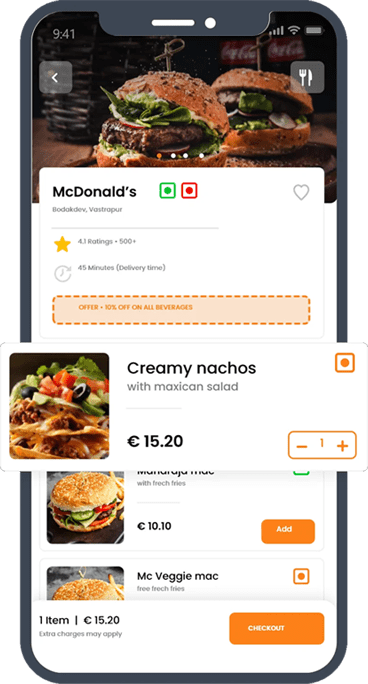
Conquer the booming food delivery market with a custom-built app. This guide explores everything you need to know about food delivery app development, from features and cost to trends and success strategies.
The Rise of Food Delivery Apps
The food delivery industry is experiencing a meteoric rise, driven by the convenience and accessibility it offers to consumers. With the increasing demand for on-demand services, food delivery apps have become an indispensable part of our daily lives.
This surge in popularity presents a lucrative opportunity for entrepreneurs and businesses to enter the market with their own food delivery platforms. However, developing a successful food delivery app requires careful planning, strategic execution, and a deep understanding of the current landscape.
Essential Features for Your Food Delivery App
To stand out in the competitive market, your food delivery app must offer a seamless and user-friendly experience for both customers and restaurants. Here are some key features that are essential for your app:
- User Registration and Profiles: Allow users to easily create accounts with basic information and preferences.
- Restaurant Listings and Search: Provide a comprehensive list of restaurants with advanced search filters based on cuisine, location, price range, and dietary restrictions.
- Menu Browsing and Ordering: Offer a clear and intuitive interface for users to browse menus, add items to their cart, and place orders seamlessly.
- Real-time Order Tracking: Enable users to track their orders in real-time, including the estimated delivery time and driver location.
- Secure Payment Gateway: Integrate secure payment gateways to ensure safe and convenient transactions for both users and restaurants.
- Push Notifications: Keep users informed about order updates, promotions, and other relevant information through timely notifications.
- Rating and Review System: Facilitate user feedback through a robust rating and review system to build trust and improve service quality.
- Promotions and Discounts: Attract and retain users with enticing promotional offers and discounts.
- Multi-language Support: Cater to a wider audience by offering your app in multiple languages.
- Geolocation Services: Leverage geolocation features to personalize user experience and optimize delivery routes.
- Social Media Integration: Allow users to connect with their social media accounts for easier registration and sharing experiences.
- Customer Support: Provide efficient customer support channels to address user queries and concerns promptly.
Additional Features to Consider:
- Offline Accessibility: Enable users to browse menus and saved information even without an internet connection.
- Analytics and Reporting: Gain valuable insights into user behavior and app performance through comprehensive data analysis.
- Loyalty Programs: Implement reward programs to incentivize repeat business and build user loyalty.
- AI-powered Recommendations: Utilize AI algorithms to personalize food recommendations based on user preferences and past orders.
Choosing the Right Business Model
There are several business models you can choose from when developing your food delivery app:
- Commission-based Model: Charge restaurants a commission fee on each order placed through your platform.
- Subscription Model: Offer premium memberships to users with additional benefits like free delivery, exclusive discounts, and priority service.
- Delivery Fee Model: Charge users a flat delivery fee for each order, regardless of the restaurant or order amount.
- Hybrid Model: Combine elements of different models to create a unique pricing structure.
Food Delivery App Development Trends
The food delivery app market is constantly evolving, with new trends emerging to enhance user experience and operational efficiency. Here are some key trends to watch:
- Focus on Sustainability: Consumers are increasingly conscious of environmental impact. Integrating eco-friendly packaging options and delivery methods can attract a growing segment of users.
- Hyperlocal Delivery: Partnering with local restaurants and offering hyperlocal delivery options can cater to specific neighborhoods and provide faster delivery times.
- Drone Delivery: While still in its nascent stage, drone delivery holds immense potential for revolutionizing the industry by offering even faster and more efficient deliveries.
- AI and Machine Learning: Leveraging AI and machine learning can personalize user experiences, optimize delivery routes, and predict order demand more accurately.
Cost Estimation for Food Delivery App Development
The cost of developing a food delivery app can vary depending on several factors, including:
- Features and Functionality: The complexity of features you choose to include will significantly impact the development cost.
- Development Platform: Building native apps for Android and iOS will require separate development processes, potentially increasing the cost.
- Development Team: Hiring an in-house team or outsourcing development to a dedicated agency can influence the overall cost.
As a general estimate, expect to invest anywhere between $20,000 and $100,000 for a basic food delivery app with essential features. More complex apps with advanced functionalities can cost upwards of $200,000 or more.
Building a Successful Food Delivery App: Key Strategies
Venturing into the food delivery app market requires a strategic approach to ensure long-term success. Here are some key considerations:
- Market Research and Competitor Analysis: Conduct thorough research to understand the existing market landscape, identify your target audience, and analyze your competitors’ strengths and weaknesses.
- Develop a User-Centric Design: Prioritize user experience by creating a clean, intuitive, and user-friendly interface that is easy to navigate and operate.
- Focus on Quality and Reliability: Ensure your app functions flawlessly with minimal bugs and crashes to maintain user trust and satisfaction.
- Invest in Marketing and Promotion: Implement effective marketing strategies to reach your target audience and build brand awareness.
- Partner with Restaurants: Establish strong partnerships with restaurants to offer a diverse selection of cuisines and ensure timely order fulfillment.
- Continuous Improvement and Updates: Regularly collect user feedback, analyze data, and implement updates to enhance your app’s functionality and address any emerging needs.
Conclusion
Developing a successful food delivery app requires careful planning, strategic execution, and a commitment to providing a seamless user experience. By incorporating the essential features, following current trends, and adopting the right strategies, you can carve your niche in this dynamic and lucrative market.